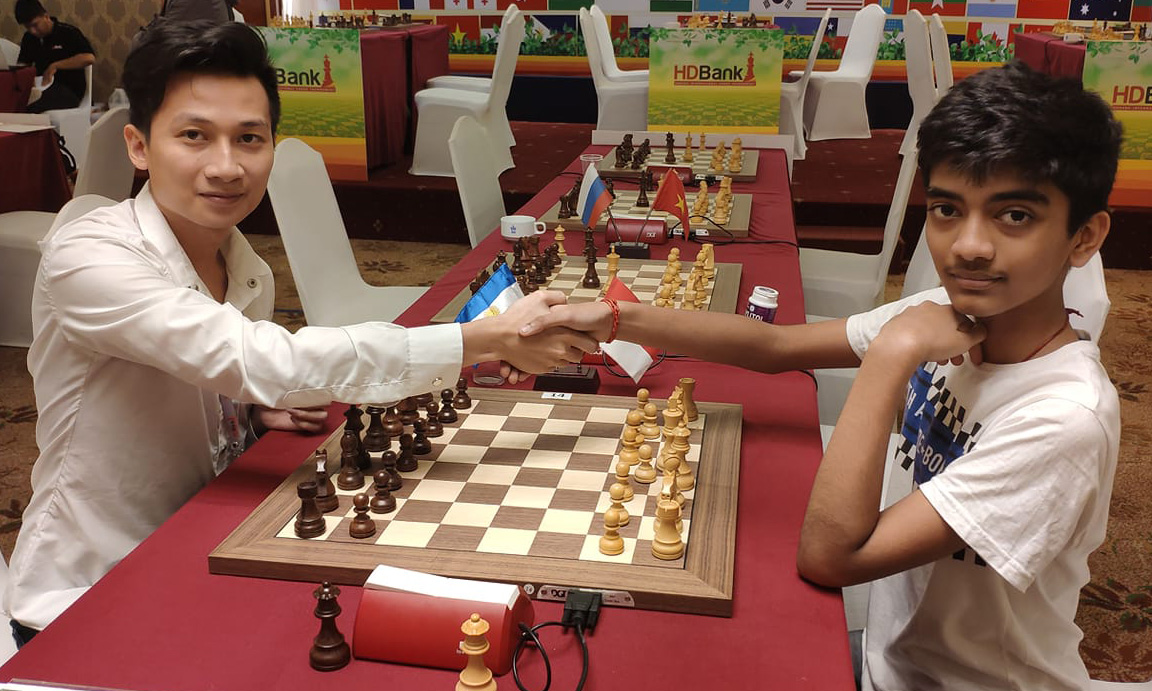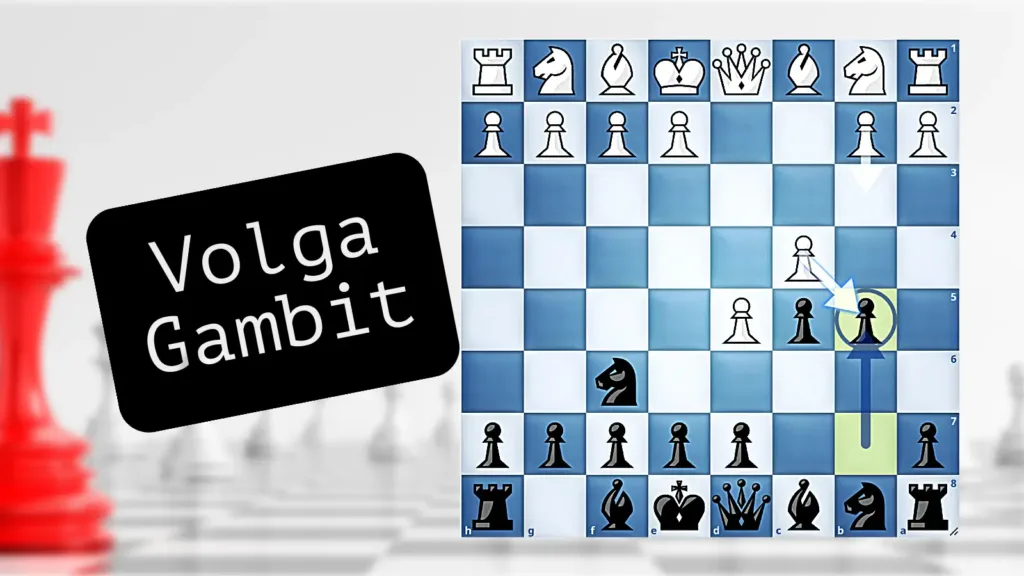This Volga Gambit (also known as the Benko Gambit) is a beautiful demonstration of how Black can generate lasting queenside pressure, tie down White’s pieces, and win a positional war through patient play and harmonious coordination. Let’s go through the game step by step and highlight how Black dominated.
Key Ideas for Black in the Volga Gambit
The Volga Gambit is an ambitious and dynamic chess opening that arises from the Benoni Defense and features an early queenside pawn sacrifice.
In the Benoni, Black often struggles to achieve …b5, needing moves like …Na6–c7, …b6, …a6, and …Rb8. But in the Benko, Black plays …b5 immediately, as a gambit.
In this line, Black offers a pawn to gain long-term pressure on the queenside, rapid piece activity, and control over key files and diagonals. The gambit can be accepted or declined, each leading to rich and distinct strategic battles.
In the main line:
Key themes:
- Control of the long dark diagonal, especially central squares (e.g., …Nfd7–e5)
- Pressure on the d5-pawn
- Queen’s-side initiative: …Qb6, …Rfb8, …Nbd7–b6–c4. White’s extra pawn often freezes in fear on a3/a4.
- Potential central breakthrough: …e6, …d5
Despite being a gambit, Black is often happy to exchange Queens. The Queen’s-side initiative lives on, while White loses attacking chances.
Main Lines and Variations
Main Line
1.d4 Nf6 2.c4 c5 3.d5 b5 4.cxb5
- 4.Nf3 b4
4…a6 5.bxa6
- 5.e3
- A) 5…axb5 6.Bxb5 Qa5+ 7.Nc3 Bb7
- A1) 8.Nge2
- a) 8…Bxd5 9.0-0 Bc6 10.a4 (or 10.Qd3) 10…Bxb5
- b) 8…Nxd5 9.0-0 Nf6
- A2) 8.Bd2 Qb6 9.Qb3 (or 9.Nge2, 9.Bc4, 9.Nf3) 9…e6 10.e4 Nxe4 11.Nxe4 Bxd5 12.Qd3 Qb7
- B) 5…Bb7
- C) 5…e6
- D) 5…g6 6.Nc3 Bg7
- D1) 7.Bc4
- D2) 7.a4 0-0 8.Ra3 (or 8.e4, 8.Bc4) 8…Bb7 9.Nh3
- D3) 7.Nf3 0-0 (or 7…d6) 8.a4 Bb7 9.Ra3 (or 9.Rb1, 9.Bc4, 9.bxa6)
- 5.f3 e6 (or 5…g6)
- 6.e4 exd5 (or 6…c4, 6…Qc7)
- 7.e5 Qe7 8.Qe2 Ng8 9.Nc3 Bb7 10.Nh3 c4
- 5.Nc3 axb5 (or 5…Qa5) 6.e4 b4 7.Nb5 d6 8.Bc4 (or 8.Bf4) 8…Nbd7
Typical Game Line
Illustrative Games
1. Queen-side attack
White, RG – Homer, SJ: Surrey Individual #4, 1988
You can see this Volga Gambit is a beautiful demonstration of how Black can generate lasting queenside pressure, tie down White’s pieces, and win a positional war through patient play and harmonious coordination.
Why It’s So Hard for White
- Queenside bind: From moves 14 onward, White had no active queenside play and was forced to respond to threats.
- Rook activity: Black’s rooks were monsters on open and semi-open files, controlling key entry points.
- Strategic clarity: Black had a plan (queenside pressure) and stuck to it; White reacted the whole game.
- b4? mistake: Highlighted how one structural mistake in Volga can spiral into permanent weakness.
- Typical Volga suffering: This is a textbook illustration of how White can slowly suffocate in the Volga, especially if they can’t generate central or kingside counterplay.
2. White locks up the Queen’s-side, Black breaks through the centre
Parker, C – Homer, S
That game is another fantastic positional showcase of the Volga Gambit, where Black sacrifices a pawn for long-term queenside pressure. But this time, White responds with precise centralization and coordination, flipping the script and winning convincingly.
Let’s break down how this clash unfolded, why it’s instructive, and how White survived the pressure to eventually outplay and out-calculate Black.
Ignore the tactical battle in the end of middlegame, Black followed a classic Volga recipe: sacrifice a pawn for long-term activity on the queenside and pressure along open files. White was more relax after closing the queenside.
3. White plays actively in the centre
Jepps, G – Homer, S: Exeter Premier, 1996
The position was dynamically balanced, but White overplayed with the flashy Rxe8+, giving away coordination.
4. Active centre play, part 2
Jepps, G – Homer, S: Somerset vs. Devon, 1996
This is a demonstration of how volatile tactical positions can often reset after the fireworks if not converted with precision.
Origin and History
Though associated with Grandmaster Pal Benko in Western chess literature, the line was known earlier as the Volga Gambit, particularly in Eastern Europe. The name references the Volga River, inspired by a 1946 article by B. Argunow in the Soviet chess magazine Shakhmaty v SSSR, written in Kuibyshev (now Samara), Russia.
Historically, the idea of playing …b5 and …a6 as an early pawn sacrifice dates back to games from the 1930s. Notably:
- Karel Opočenský vs. Gideon Ståhlberg (Poděbrady 1936)
- Paul Keres (Pärnu 1937)
- David Bronstein vs. Mark Taimanov (Candidates, Zürich 1953)
These games often started as King’s Indian Defenses, only later transitioning into Volga-like structures.
In his 1974 book The Benko Gambit, Pal Benko distinguished between the Volga Gambit (3…b5, occasionally followed by …e6) and the Benko Gambit (3…b5 4.cxb5 a6). Today, the terms are largely used interchangeably.
Famous Practitioners
Though named “Volga” in its early history, the line became widely associated with Pal Benko, who popularized it at high-level events and through publications.
Top grandmasters who have employed the Volga Gambit include:
- Mikhail Tal
- Garry Kasparov
- Magnus Carlsen
- Viswanathan Anand
- Veselin Topalov
- Alexei Shirov
- Michael Adams
- Vasyl Ivanchuk
- Boris Gelfand
It remains a favorite at the club and tournament level due to its clarity of plans and aggressive nature.
The Volga Gambit is a powerful weapon in Black’s arsenal, combining material sacrifice with enduring positional pressure. Its soundness, even into the endgame, makes it a unique gambit and a rare case where the initiative outlasts the pawn.
Players seeking unbalanced, dynamic games with active piece play and counterattacking chances should consider adding the Volga Gambit to their repertoire.

I’m Xuan Binh, the founder of Attacking Chess, and the Deputy Head of Communications at the Vietnam Chess Federation (VCF). My chess.com and lichess rating is above 2300. Send me a challenge or message via Lichess. Follow me on Twitter (X) or Facebook.

